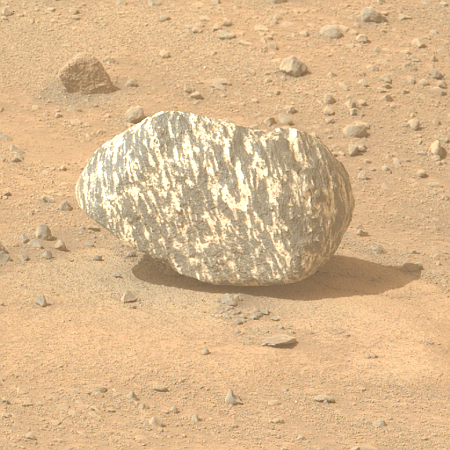A puzzling striped rock on Mars
Cool image time! The picture to the right, cropped, reduced, and sharpened to post here, was taken on September 13, 2024 by one of the high resolution cameras on the Mars rover Perseverance. The rock’s striped nature makes it unique, unlike any feature spotted by any rover previously. From an update today:
The science team thinks that this rock has a texture unlike any seen in Jezero Crater before, and perhaps all of Mars. Our knowledge of its chemical composition is limited, but early interpretations are that igneous and/or metamorphic processes could have created its stripes. Since Freya Castle [the name the science team gave the rock] is a loose stone that is clearly different from the underlying bedrock, it has likely arrived here from someplace else, perhaps having rolled downhill from a source higher up. This possibility has us excited, and we hope that as we continue to drive uphill, Perseverance will encounter an outcrop of this new rock type so that more detailed measurements can be acquired.
Without doubt the rock’s rounded surface suggests it was ground smooth by either water or ice. That surface certainly resembles glacial cobble seen across the northeast of the U.S. where ice glaciers once covered the entire landscape. The rock also resembles river cobble, smoothed by flowing water.
The stripes however suggest that prior to its being smoothed, this rock underwent a much more complex geological process, whereby two different materials were intermixed and squeezed together.
On Christmas Eve 1968 three Americans became the first humans to visit another world. What they did to celebrate was unexpected and profound, and will be remembered throughout all human history. Genesis: the Story of Apollo 8, Robert Zimmerman's classic history of humanity's first journey to another world, tells that story, and it is now available as both an ebook and an audiobook, both with a foreword by Valerie Anders and a new introduction by Robert Zimmerman.
The print edition can be purchased at Amazon or from any other book seller. If you want an autographed copy the price is $60 for the hardback and $45 for the paperback, plus $8 shipping for each. Go here for purchasing details. The ebook is available everywhere for $5.99 (before discount) at amazon, or direct from my ebook publisher, ebookit. If you buy it from ebookit you don't support the big tech companies and the author gets a bigger cut much sooner.
The audiobook is also available at all these vendors, and is also free with a 30-day trial membership to Audible.
"Not simply about one mission, [Genesis] is also the history of America's quest for the moon... Zimmerman has done a masterful job of tying disparate events together into a solid account of one of America's greatest human triumphs."--San Antonio Express-News
Cool image time! The picture to the right, cropped, reduced, and sharpened to post here, was taken on September 13, 2024 by one of the high resolution cameras on the Mars rover Perseverance. The rock’s striped nature makes it unique, unlike any feature spotted by any rover previously. From an update today:
The science team thinks that this rock has a texture unlike any seen in Jezero Crater before, and perhaps all of Mars. Our knowledge of its chemical composition is limited, but early interpretations are that igneous and/or metamorphic processes could have created its stripes. Since Freya Castle [the name the science team gave the rock] is a loose stone that is clearly different from the underlying bedrock, it has likely arrived here from someplace else, perhaps having rolled downhill from a source higher up. This possibility has us excited, and we hope that as we continue to drive uphill, Perseverance will encounter an outcrop of this new rock type so that more detailed measurements can be acquired.
Without doubt the rock’s rounded surface suggests it was ground smooth by either water or ice. That surface certainly resembles glacial cobble seen across the northeast of the U.S. where ice glaciers once covered the entire landscape. The rock also resembles river cobble, smoothed by flowing water.
The stripes however suggest that prior to its being smoothed, this rock underwent a much more complex geological process, whereby two different materials were intermixed and squeezed together.
On Christmas Eve 1968 three Americans became the first humans to visit another world. What they did to celebrate was unexpected and profound, and will be remembered throughout all human history. Genesis: the Story of Apollo 8, Robert Zimmerman's classic history of humanity's first journey to another world, tells that story, and it is now available as both an ebook and an audiobook, both with a foreword by Valerie Anders and a new introduction by Robert Zimmerman.
The print edition can be purchased at Amazon or from any other book seller. If you want an autographed copy the price is $60 for the hardback and $45 for the paperback, plus $8 shipping for each. Go here for purchasing details. The ebook is available everywhere for $5.99 (before discount) at amazon, or direct from my ebook publisher, ebookit. If you buy it from ebookit you don't support the big tech companies and the author gets a bigger cut much sooner.
The audiobook is also available at all these vendors, and is also free with a 30-day trial membership to Audible.
"Not simply about one mission, [Genesis] is also the history of America's quest for the moon... Zimmerman has done a masterful job of tying disparate events together into a solid account of one of America's greatest human triumphs."--San Antonio Express-News



Go with the simplest explanation. A Martian dropped it after carrying it from somewhere else ’cause he found a prettier one.
Mars Guy discussed this rock last weekend:
https://www.youtube.com/watch?v=ZZZnWnROzIU
Looks like a glacial erratic.
“They call me the wanderer
Yeah, the wanderer
I roam around, around, around”